Irrespective of the difficult night that I had had on account of the poisoning of the previous evening and the currently very much present feeling of heaviness, we had already arranged a whole-day excursion for this day, so I eventually simply got ready and moved. After all, we had to leave our hotel room, but at least we could leave our luggage at the hotel.
This is a bad thing when you are travelling and your journey is such that you keep moving. Then you actually don’t have a real chance to rest and recuperate well. On the other hand, perhaps on this day this turned out to be a good thing, since that moving forced me to get better in a way, albeit slowly, and by later that afternoon I felt as if nothing had happened.
First we went by a taxi we had rented for the day to village Ponda near which there are several plantations for the production of tropical spices. Concretely, we went to the Sahakari Spice Farm. There we were greeted by some girls who sang for a while, while we waited for a small group of tourists to be formed there on the spot in order for all of us to go and do the visit together.
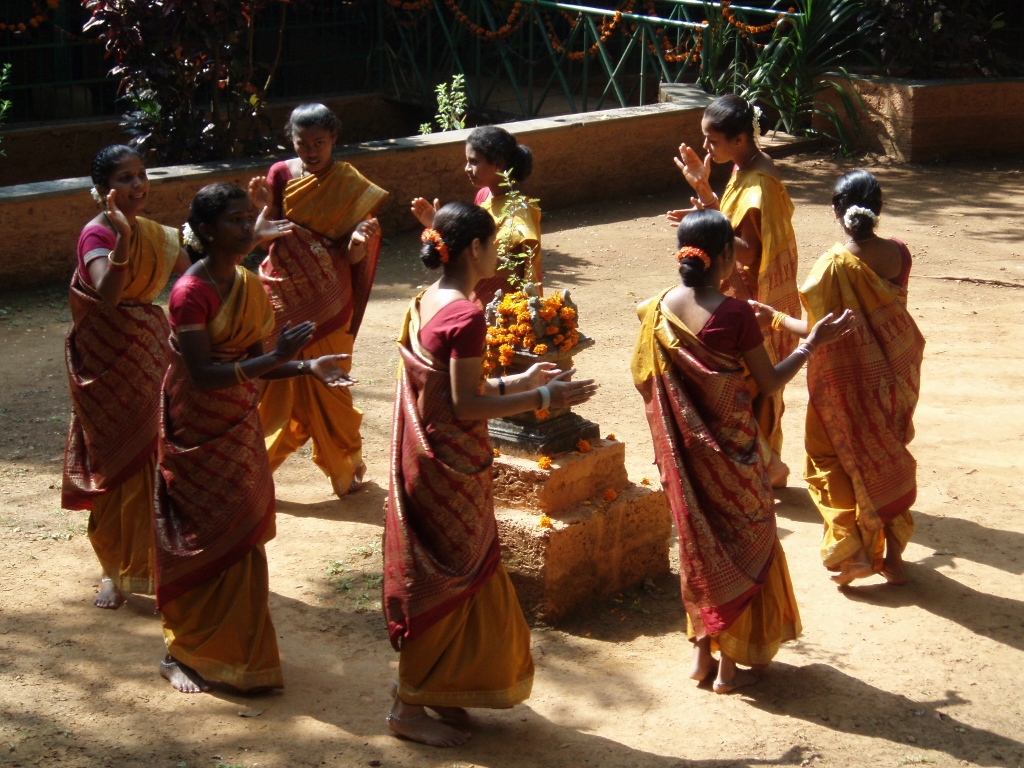 Greeting at the spice farm
Greeting at the spice farm
So, with one girl as a guide, we started with a walking tour around the plantation. I still felt weak and my stomach was completely wobbly inside, but there was nothing else for me to do. I just followed the group. Thus we saw vanilla, turmeric, cinnamon, nutmeg, cardamom, black pepper, as well as coffee, bananas, papaya, cashews...
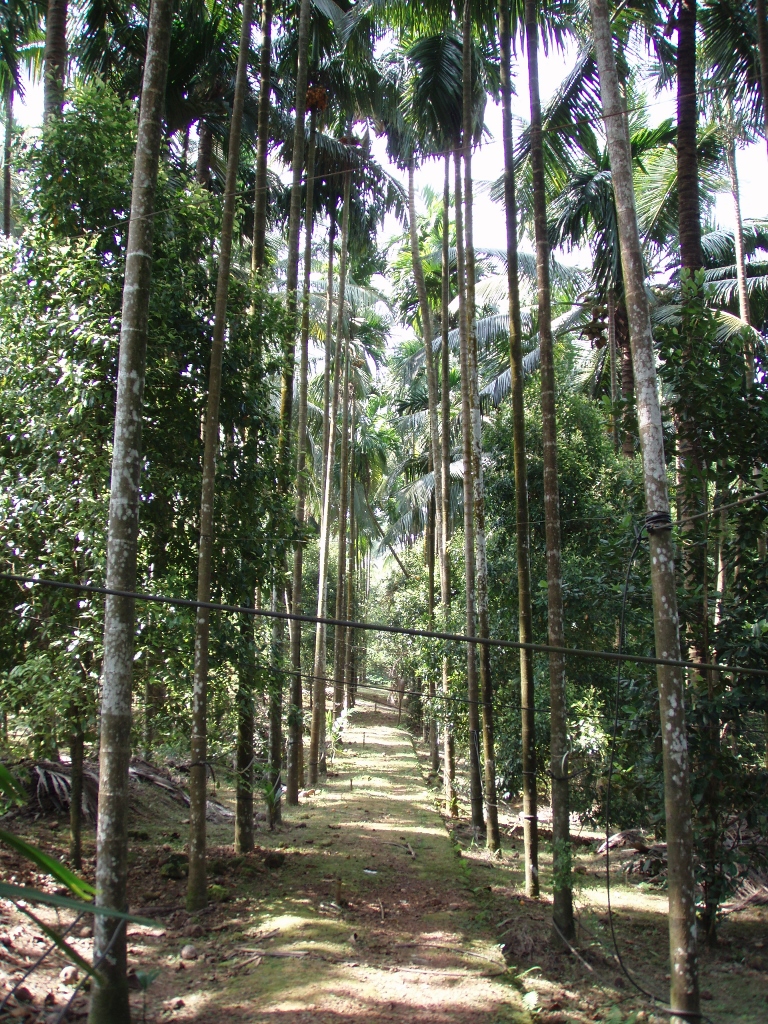 A line of trees at the tropical spices plantation
A line of trees at the tropical spices plantation
Among the first plants to see was the vanilla. This is actually a type of orchid that grows like a vine along tree trunks. Vanilla is the second most expensive spice in the world (after saffron). As this girl who was the guide told us, the reason for this is that vanilla cannot bear a lot of “fruits” in the shape of pods unless artificially pollinated and this pollination is in fact done manually.
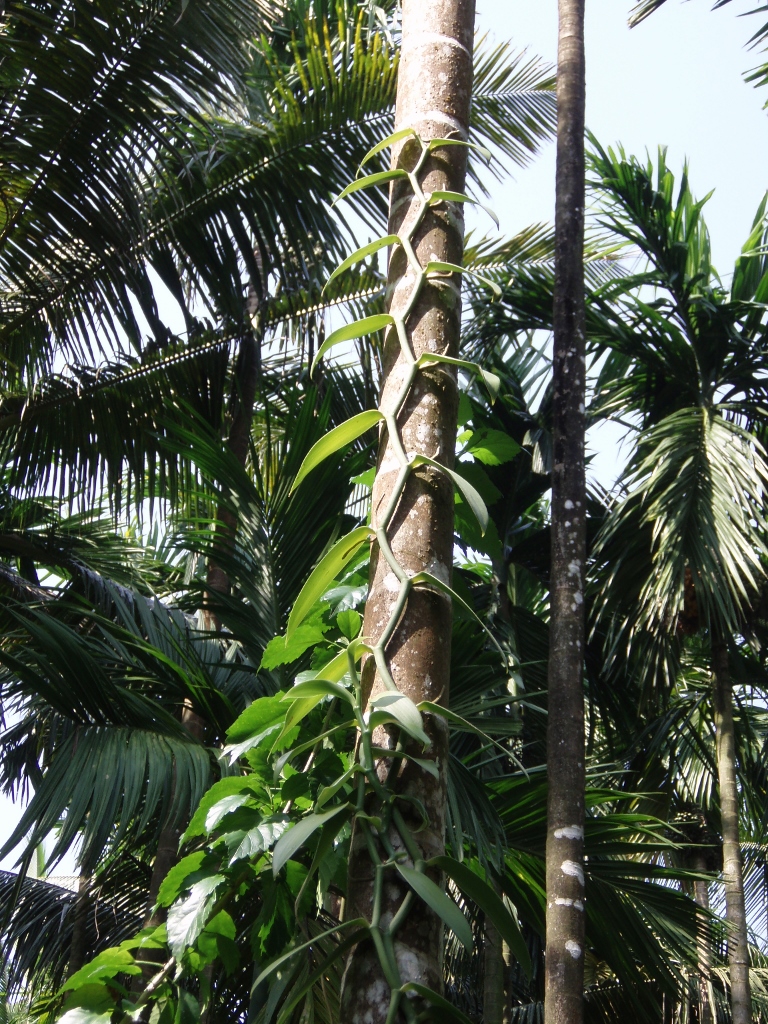 Vanilla plant climbing a tree
Vanilla plant climbing a tree
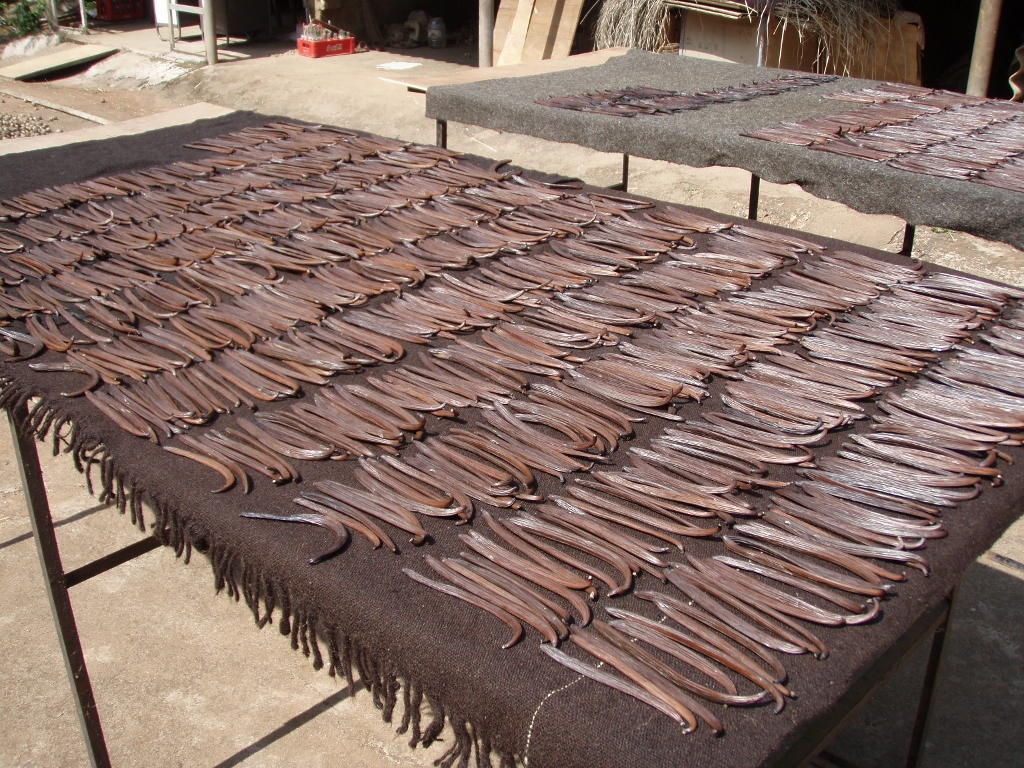 Vanilla pods are drying
Vanilla pods are drying
Then we also came to the nutmeg and this is a completely fascinating plant. It is already known that the hard seed found in the also hard shell is used as seasoning by being finely ground. But, there is another part that is used as seasoning and this is the soft membrane that enwraps the hard membrane or the shell. When fresh, it is of bright red colour, and after the drying and before being used, its colour changes and becomes somehow dimmed.
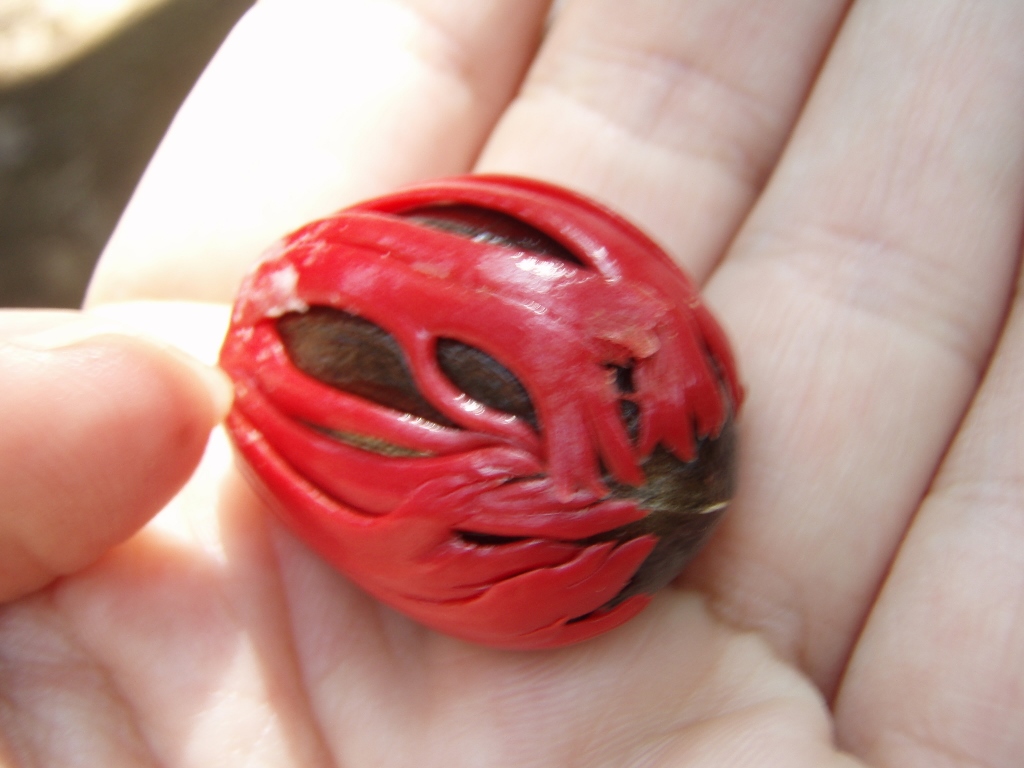 Nutmeg with its two membranes
Nutmeg with its two membranes
There was, of course, the unavoidable black pepper or simply pepper which originates precisely from India. I found it interesting that the black pepper berries that are used as seasoning, after all like the green ones, come from unripe fruits, while only the white pepper is obtained from fully ripe berries. By the way, the reddish one that is seen around is not proper pepper that comes from India, but rather that one comes from Latin America. Also, pepper grows in clusters.
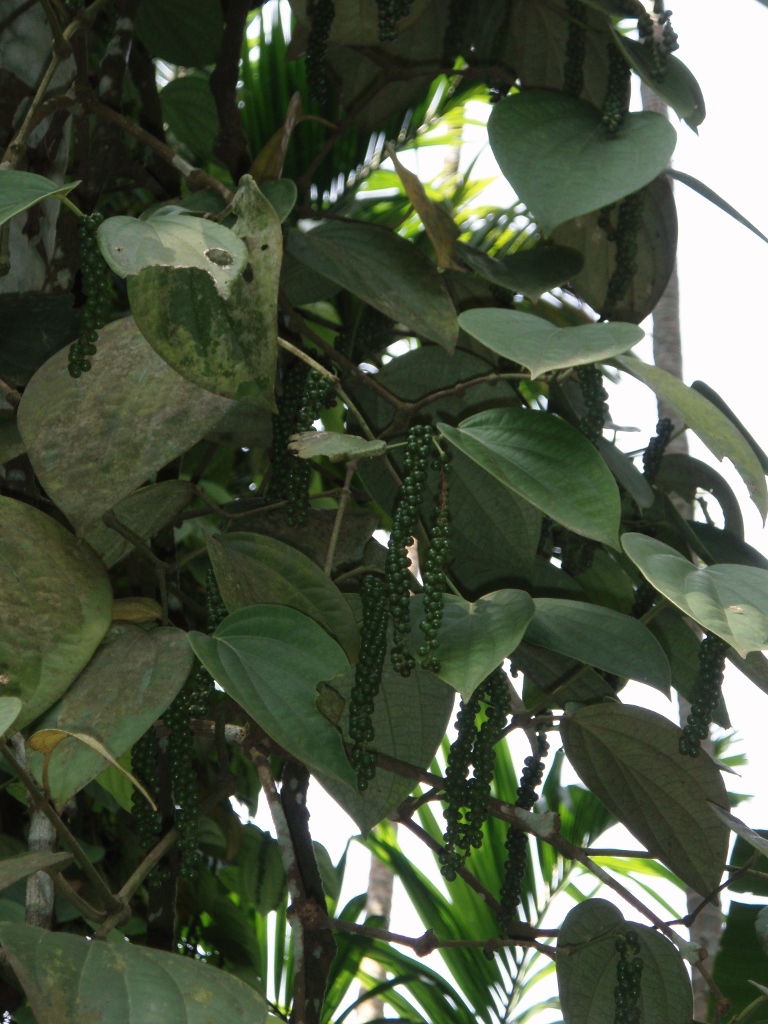 Pepper clusters
Pepper clusters
Within the scope of these farms where tourists visit the plantations of spices and other plants, there is also a possibility to ride elephants. Thus, at the end of the walk, visitors come to a clearing with elephants waiting and whoever wants may pay extra and get onto an elephant. I guess then they walk a little and it is also possible just to take photos. Be as it may, the animals were truly beautiful, but I did find it sad when I saw that one of their legs was bound by a rope or a chain. Sneža, of course, immediately took some nuts that we had on us and started feeding one of the elephants that first took them into his trunk and then popped them into his mouth.
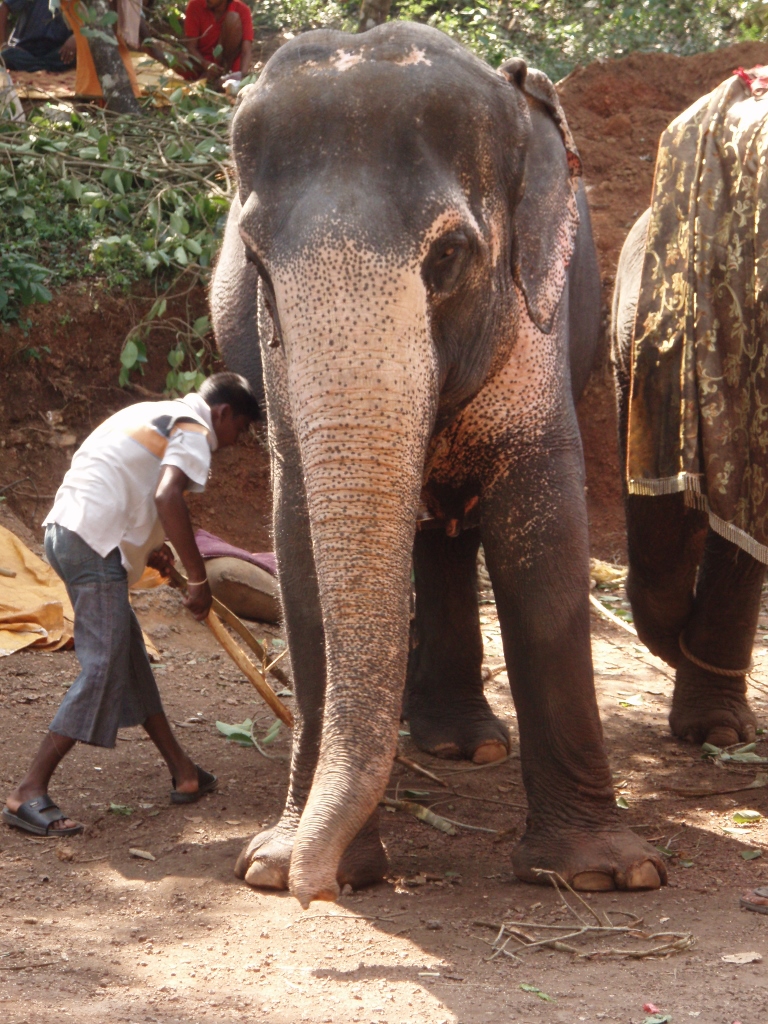 One of the elephants waiting for tourists
One of the elephants waiting for tourists
In the end, we also had lunch, but I could not really eat. I only took a small piece of bread and some potatoes, just to make sure my stomach was not completely empty. Then we bought some spices and essential oils at the farm, after which we moved on. We made a stop at a temple in Ponda, but I was not interested in that, nor did I have the strength or the desire to visit anything I could avoid. Sneža quickly went to the temple, but did not stay there for too long since it was extremely crowded, so we moved to Old Goa which is also called Velha Goa (the same meaning, but in Portuguese). I still did not feel too well, but here I did not have much choice, so I got out of the car and thus the two of us started with our sightseeing walk.
Goa had a very turbulent past, but its rulers were mostly, so to speak, local. Then in 1510 came the Portuguese who took this part of the lands and turned it into their colony. It is usually said that India was a British colony and that is certainly true; most of the Indian territory was a colony of Great Britain. Still, although the Brits ruled the largest portion of the territory, they were not the only colonialists. The Portuguese, as well as the Dutch and the French, also used to have their colonies here. At least during this journey Sneža and I, by coincidence, visited the former colonies of these particular West-European powers.
More about these other colonies a little later and now let me just mention that the Portuguese ruled here until 1961 when India annexed this territory, but Goa acquired the formal status of a federal state (India is in fact a federation and it consists of federal states) only on 30 May 1987. It is the smallest federal state in India. The capital of the Portuguese colony was in fact Old Goa, i.e., Velha Goa, while today’s capital is Panaji that is often called Panjim.
As very devout Catholics, the Portuguese spread their religion, often at any cost. Since I’m talking about the subject of colonies and religion, let me also mention that it was precisely during my travels in Latin America and here in India that I started to realise that colonialism is not some general, unique notion applicable to all. Of course, what all the colonies had in common was that the colonial countries sucked out the natural resources and riches and used the people in the countries they had conquered. In all of this, they went from aggression to horrifying atrocities, but it still seems to me that there are two basic types of colonialism – the Spanish-Portuguese one and the British one, while all of that somehow was mostly reflected through religion.
As opposed to the Brits who are Anglicans and who in principle never even bothered with converting local population, perhaps because they always looked at their subjects haughtily and simply never ever wanted to mix with them, not even in a church (and certainly there was not a large number of official marital relations between the Brits and the local population, if any at all), the Spanish and the Portuguese wanted wholeheartedly to convince the local population to believe in the same God as themselves. By the way, the Spaniards in particular liked very much to mix with the local population and here I’m primarily thinking of the physical mixing in a bed. I remember that many years ago when I was first in Mexico I saw a document in one of the museums which looked like an organigram, while in fact listing the words that signified persons born from different combinations: white-red, white-black, red-black and a couple of generations of their descendents and the results of further mixing. In order for something like that, such as different official or unofficial interracial physical bonds that lead to the births of descendents, to enter the language it is really necessary that this phenomenon is present to a sufficient or a critical degree. It was precisely these mixed descendents in Latin America who actually no longer truly belonged to the motherland that started the rebellions and revolutions aimed at freeing these countries from the colonialism. Needless to say, all of that was basically revolving around money and the division of the wealth, but the fact remains that the descendents of those mixed liaisons were connected more to the country in which they were born and less to some distant country in another continent from which some of their ancestors came from – just some, not all of them. There is nothing of the kind in the case of the British colonies. The Brits came, conquered the territories and took what they wanted, while having minimal contacts with the locals. In that way they could never develop the same level of connectedness to the given territory, but rather they always stayed linked only to their homeland. Of course, this is only my personal theory and I’m talking only in general terms. But, this theory makes sense to me, so I like to look at the things in this way.
Now let me go back to India of 2007 and Old Goa. So, like the Spanish in Latin America, the Portuguese wanted dearly to spread their religion both in Brazil and here in Goa. Perhaps that’s the catch – the Catholicism feels a greater need to proliferate than the Anglicanism. Be as it may, the Portuguese were present here for about 450 years and therefore in their local capital they built a large number of impressive churches.
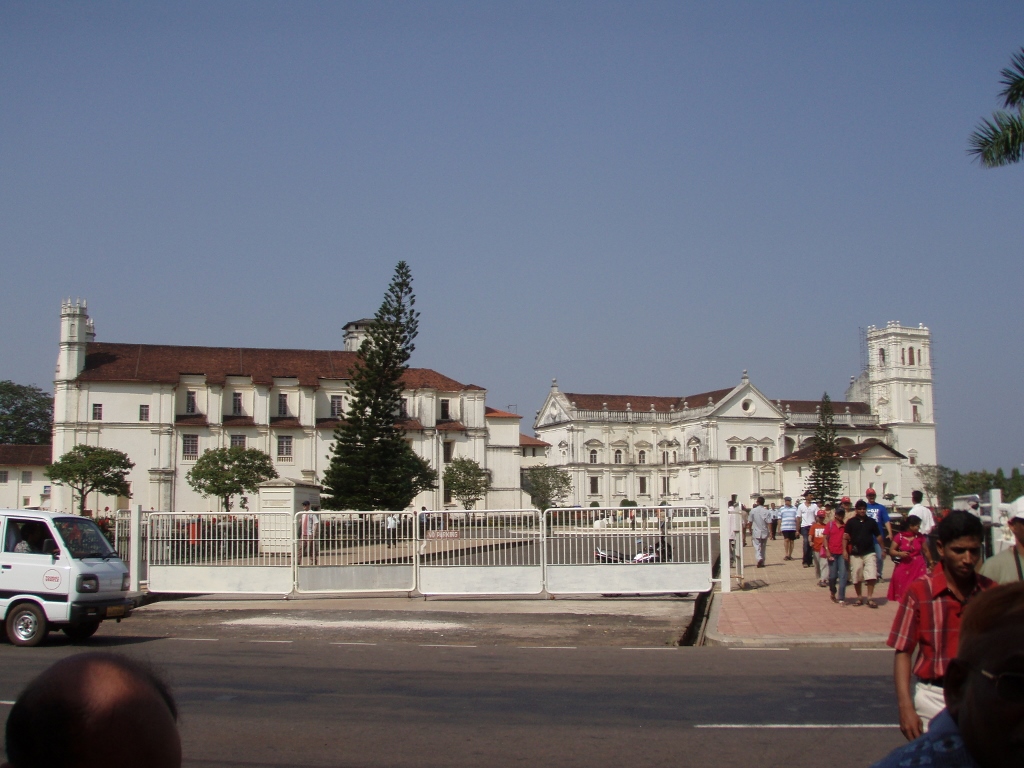 Old Goa: Church of St Francis of Assisi (left) and the Se Cathedral (right)
Old Goa: Church of St Francis of Assisi (left) and the Se Cathedral (right)
We started with our sightseeing visit with the Basilica of Bom Jesus the construction of which was completed in 1605.
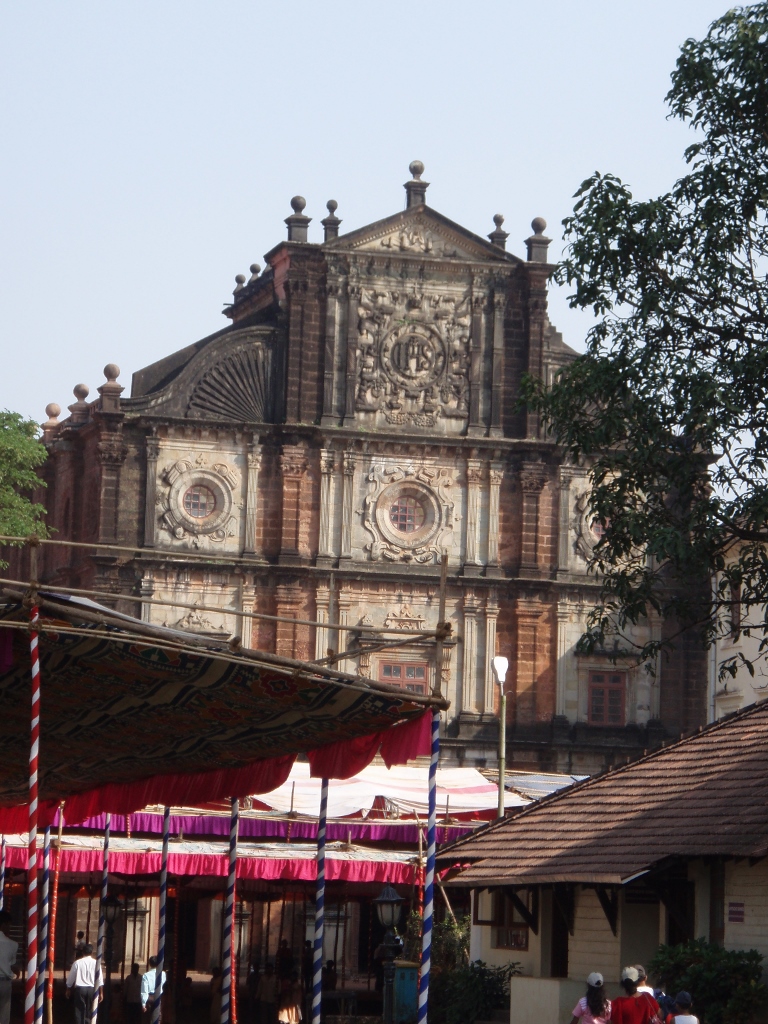 Basilica of Bom Jesus
Basilica of Bom Jesus
This church is revered by Roman Catholics throughout the world, since it contains the relics of Goa’s patron saint – St Francis Xavier who was one of the founders of the Jesuit order. It is believed that after Saint Peter, it was him who converted the highest number of people (he worked throughout Asia) and in connection with that there are also some controversies. Namely, in his zealousness linked to the conversion of the local population in Goa, in 1546 Francis Xavier requested that Portugal sent the Inquisition here, which these were more than willing to oblige. The Goan Inquisition was active until 1820 and when they were abolished, they nicely burned all the historical documentation that testified to what they had really done. It is, naturally, quite well known that they were very brutal and that a large number of people were tortured and/or killed, among other ways, by starvation or burning at stakes.
Often, when I think about human hypocrisy, as well as about why I don’t like what I call “organised religions” because by the rule they come down to the human interpretation of the God’s intentions, I remember this story about Goa, the conversion and the Inquisition. And inevitably a simple question comes to my mind: “What would Jesus Christ do if somebody told him that they did not want to believe in him?” He would deprive them of food until they died? He would burn them at stakes? And this was precisely what was done in His name. I do hope that now and forever it is precisely these people who brutalised others that are burning, but not until the stakes have been extinguished, but in that eternal, hell’s fire. They do not deserve any better.
So, we entered the Basilica of Bom Jesus and walked around it a little. I found the church more interesting from the outside than from the inside. Its altar section was covered in gilded elements, but as a rule I’m not impressed by golden altars. This only means that those who built these churches had more money which most often they did not give from their own pockets, so they could flaunt it as much as they liked.
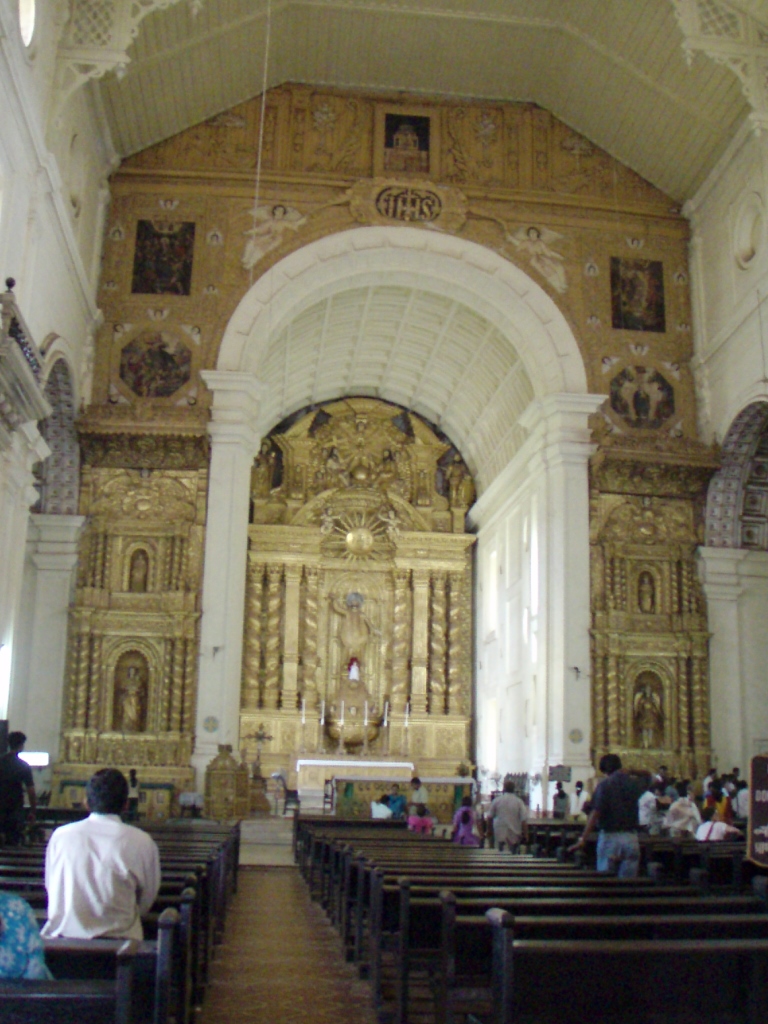 Basilica of Bom Jesus, the altar
Basilica of Bom Jesus, the altar
We went to the cloister that belongs to the Basilica of Bom Jesus and then we left the church, crossed the street and a park, and walked over to the Se Cathedral.
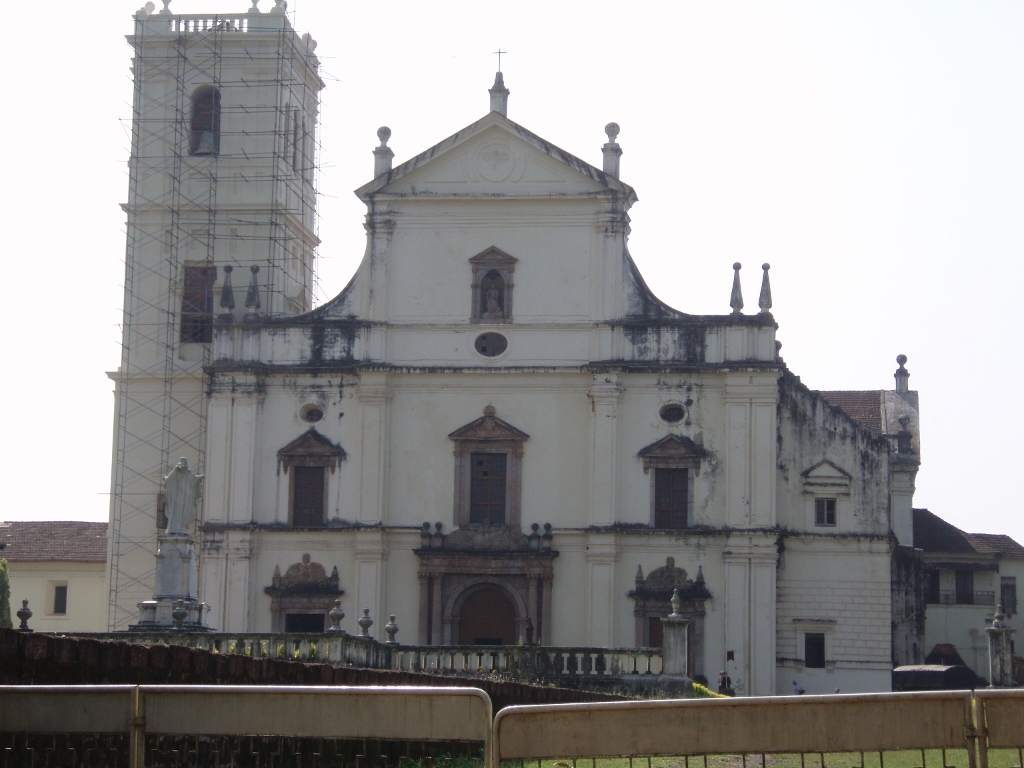 Se Cathedral
Se Cathedral
This is one of the biggest churches in Asia and certainly the biggest one in Old Goa; it is 76 m long and 55 m wide. Its construction in the place of the previous church started in 1562 and was completed in 1619. What sets it apart, among other things, is the bell which is the biggest in Asia and which is called the Golden Bell. It is situated in the tower. It is said (we did not hear it) that it renders very pretty tones and the guidebooks also mention that the bell used to toll during the Inquisition trials that took place in front of the cathedral. I don’t know about others, but I do have a huge problem with that.
The interior of the church appears quite simple, with the exception of the gilded high altar the panels of which show the scenes from the life of St Catherine of Alexandria to whom the church is dedicated.
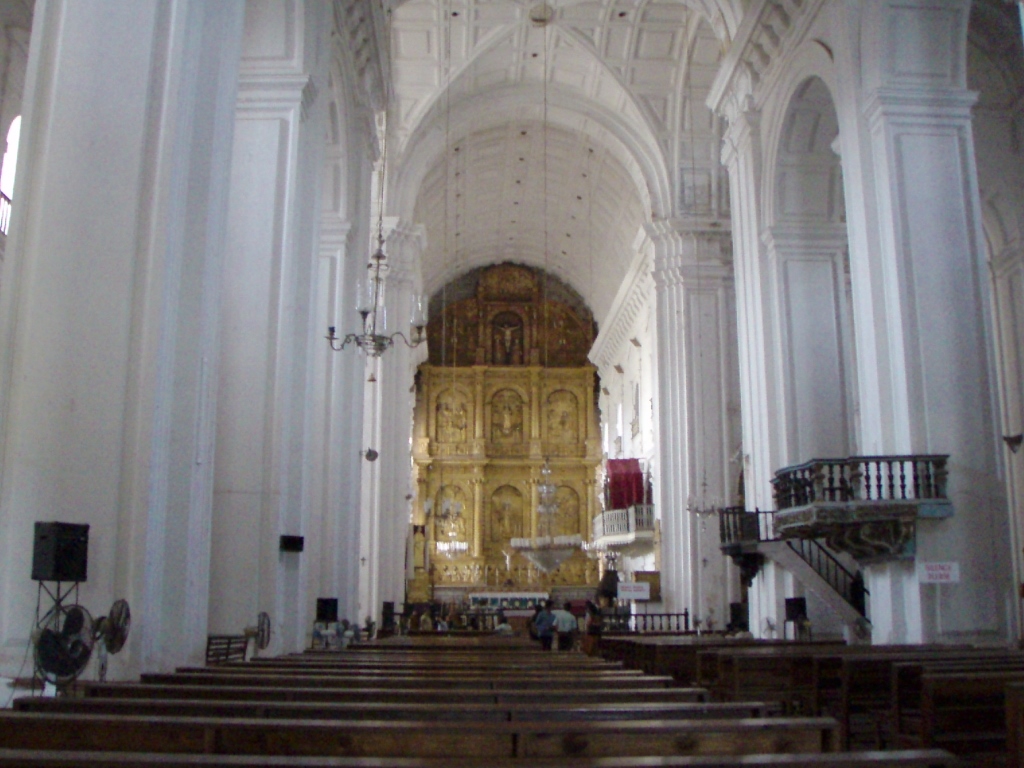 Interior of the Se Cathedral
Interior of the Se Cathedral
Then, going through a park, we headed in the direction of the Church of St Cajetan. I remember that in this section I felt exceptionally hot, i.e., my main problem lay in the enormous air humidity. But, this cannot be seen in the photo that shows a well maintained lawn and luscious greenery that surrounds it.
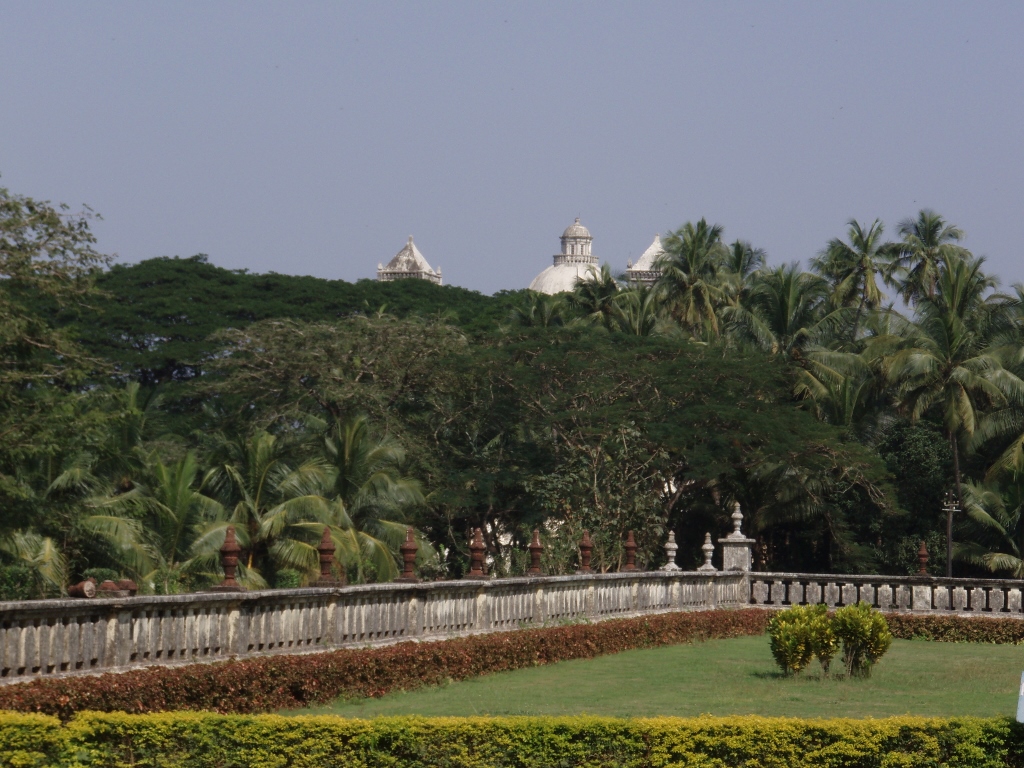 Park and the top of the Church of St Cajetan
Park and the top of the Church of St Cajetan